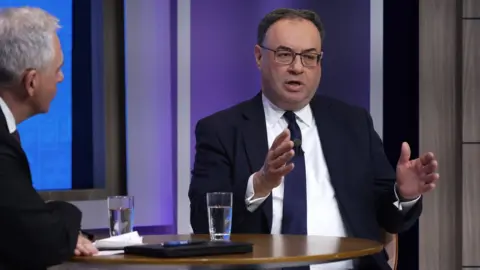Bank of England considers raising saver protection, governor says
 Getty Images
Getty ImagesThe Bank of England is considering raising the level of protection given to bank savings, following recent upheaval in the financial sector.
Currently, deposits up to £85,000 are protected if a bank fails, far less than in US banks.
Bank of England governor Andrew Bailey said he did not believe there was a risk of a 2008-style crisis.
But he questioned whether UK banks were holding enough liquidity - or available cash - to cope with short-term shocks.
Rules on how much money banks hold in case of trouble were being reviewed, as well as the bank deposit insurance scheme, he said.
Speaking at the International Monetary Fund (IMF) meeting in Washington, Mr Bailey said reforms put in place after the 2008 financial crisis had been effective during the recent turmoil, which saw rising concern over the health of the global financial system and a slide in bank shares around the world.
"The post-crisis reforms to bank regulation have worked," Mr Bailey said.
"Today I do not believe we face a systemic banking crisis. When I look at the UK banks, they are well capitalised, liquid and able to serve their customers and support the economy."
The trouble was triggered by the collapse of Silicon Valley Bank (SVB) and two other US lenders. Shortly after, Switzerland's UBS was forced to buy rival Credit Suisse.
Regulators are now focusing on whether banks need bigger cash buffers, given new challenges. In particular, the spread of news on social media and electronic banking mean that savers can move their money out of financial institutions within seconds, making them more vulnerable to sudden bank runs.
Mr Bailey said regulators shouldn't assume that current levels of liquidity protection were "correct".
"Runs can go further much more quickly," he said.
When SVB ran into difficulty, $40bn was withdrawn from the bank in 24 hours amid social media rumours, as savers were able to instantly take out their savings digitally.
The chair of the US Federal Reserve called it the fastest bank run in American history and the authorities stepped in to protect all deposits.
Standard deposit protection is already significantly higher in the US at $250,000 (£200,000).
Both the US and the EU, where deposits are protected to a comparable size as in the UK, are considering raising their levels of protection. But such moves would come at a cost to big banks, and could potentially limit flows of credit.
Protection for bank deposits, administered by the Financial Services Compensation Scheme, was increased substantially following the 2008 financial crisis. Before that savers were covered for less than £32,000 per institution.
For most individuals, there is little chance of ever having £85,000 in a bank account.
However, whenever there are wobbles in the banking sector, the safety of savings is of immediate concern to many, particularly older savers, with savings held to recover retirement - hence the wider reassurance provided by the safety net.
There is extra protection available for people who have a sudden influx of funds, due to a life event such as a divorce settlement, inheritance or payout from a life insurance policy. The "Temporary High Balance" protection covers deposits over £85,000 and up to £1m per institution for up to six months.
